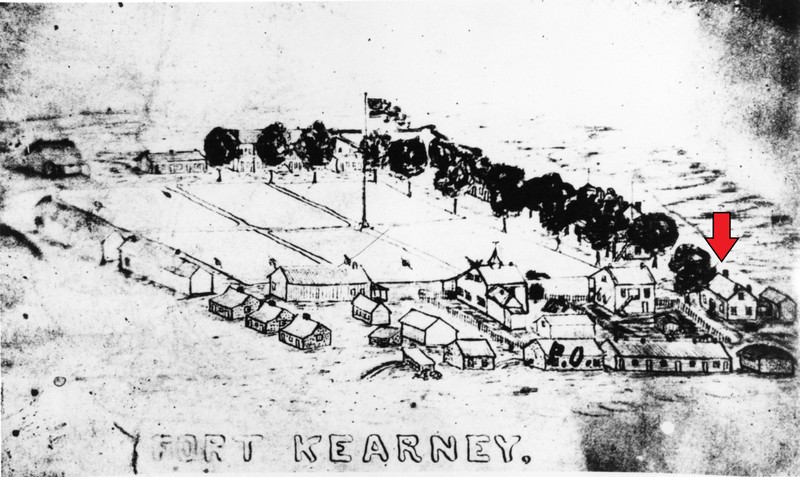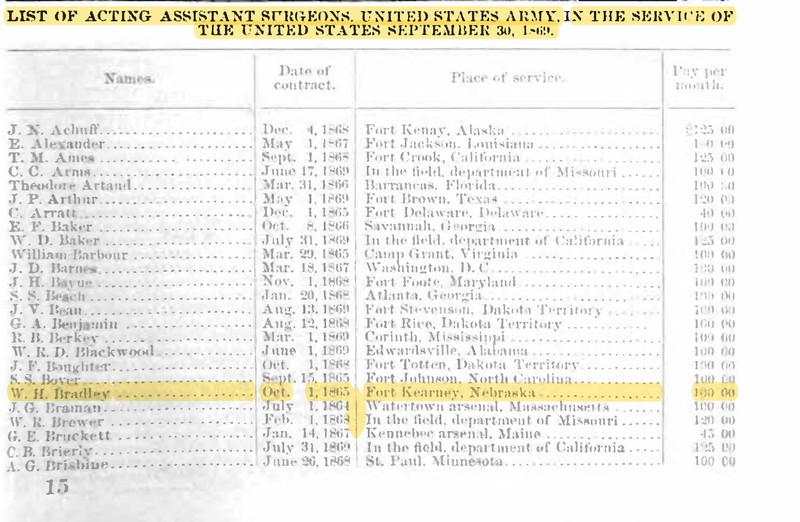Fort Kearny Hospital
Introduction
Text-to-speech Audio
Images
Drawing of Fort Kearny showing the original hospital. Later converted to the telegraph office

Official register from the War Department listing acting assistant surgeon W.H. Bradley - 1869

Backstory and Context
Text-to-speech Audio
The year 1849 saw the continued progress of Fort Kearny. Construction for the hospital began in late May, and Lt. Woodbury reported on June 2nd that the new hospital had been covered and weatherboarded and would be shingled within a day. In a report from 1852, the post-hospital was noted on the southwest corner of the parade grounds. It was described as a one-story frame building with two rooms in the attic.
The 7th Iowa Cavalry became the post garrison in the fall of 1863 and after their arrival, they constructed a log and earth magazine, a new hospital, and new log laundresses quarters. The annual report of an inspection of buildings in June 1864, indicates the original hospital was now occupied as the telegraph office, sutlers residence, and in good condition. The new hospital was located directly west of the old hospital. It consisted of three ward rooms, each twenty-five by thirty feet, a dispensary and office, a kitchen, and a laundry. The building was warmed by stoves, was well lighted but poorly ventilated. The report states that the hospital is in good condition, large and commodious with ample room to treat from eighteen to seventy-four patients. Two acres of ground are enclosed with good and substantial wire fence one half of which is cultivated as a hospital garden, the remainder is covered with a variety of trees (cottonwood, elm, and cedar planted during the last spring, and forming a very pleasant resort for the convalescent sick). No additions or repairs are necessary for the coming year.
The post surgeon, with help from the hospital steward, provided medical care to area settlers, as well as the soldiers. Several babies were born here. Since the post surgeon was usually the officer with the highest level of scientific training his duties included water and soil testing, noting meteorological conditions, recording the flora and fauna of the area, and monitoring the men’s living conditions.
From time to time post surgeons were required to report concerns on the sanitary and health conditions at their posts. In December 1869, acting assistant surgeon W.H. Bradley noted that "everything was old and dilapidated, ill-suited for hospital use." Dr. Bradley thought that a new hospital was "much needed."
Sources
Kimball, Beverly M. Fort Kearny - Guardian of the Plains. Buffalo Tales - Buffalo County Historical Society, vol. 11, no. 6. Published June 1st, 1988.
Roger T Grange Jr, “Digging at Fort Kearny,” Nebraska History 44 (1963): 101-121
Mantor, Lyle E. "The History of Fort Kearny." Ph.D. diss., 1938.
Post Inspection, Fort Kearny, N.T. June 28, 1864.
Library of Congress
